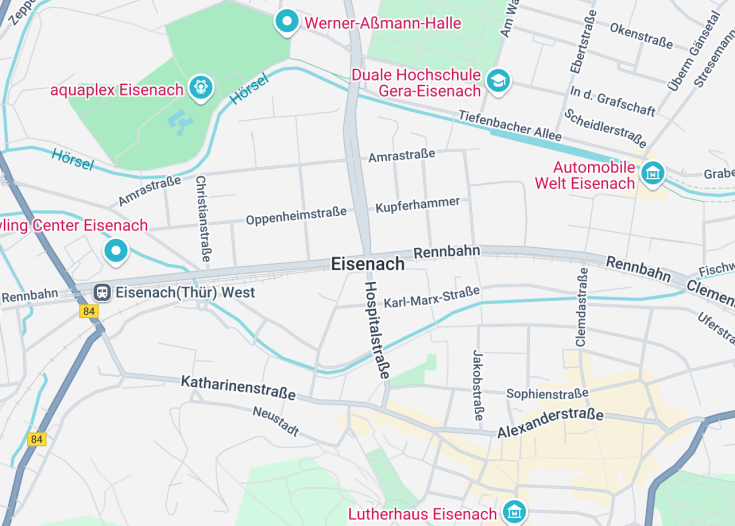Eisenach, nestled in the heart of Germany’s Thuringia region, boasts a rich tapestry of cultural and historical treasures. This picturesque town is famously associated with Martin Luther and Johann Sebastian Bach, offering visitors a deep dive into Germany’s profound musical and religious heritage.
The highlight is Wartburg Castle, a UNESCO World Heritage site, where Luther translated the New Testament into German. The town’s well-preserved medieval architecture, vibrant cultural scene, and surrounding lush landscapes make it a compelling destination for history buffs and nature lovers alike.
Before visiting Eisenach, consider exploring its extensive hiking trails. The surrounding Thuringian Forest offers panoramic views and historic sites along well-marked paths.
Allocate sufficient time to explore Wartburg Castle thoroughly. Its rich history and stunning architecture deserve in-depth exploration, ideally with a guided tour to enhance your experience.
Top things to do & see in Eisenach
Select the following sights and activities to discover best tickets and tours available in Eisenach.
Eisenach: Steeped in History and Culture
| Country | Germany |
| Time in Eisenach | GMT+1 |
| Language spoken | German |
| Population | 42,300 (Statista 2022) |
| Currency | Euro (€, EUR) |
| Airports |
|
Eisenach is a city of profound historical and cultural importance in Germany. Known primarily for its direct association with Martin Luther and Johann Sebastian Bach, the city serves as a nexus of medieval and renaissance history intertwined with modern vibrancy.
Situated in the state of Thuringia, Eisenach is not just a hub for classical history buffs but also appeals to nature lovers and adventure seekers given its proximity to the lush Thuringian Forest and the iconic Wartburg Castle, a UNESCO World Heritage site.
Where is Eisenach?
Eisenach is nestled in the heart of Germany, flanked by the Thuringian Forest to the south-west.
Distances:
| Route | Distance by car | Time by car |
|---|---|---|
| From Berlin to Eisenach | 217 miles (349 km) | Approx. 3 hours 30 minutes |
| From Frankfurt am Main to Eisenach | 163 miles (262 km) | Approx. 2 hours 30 minutes |
| From Munich to Eisenach | 263 miles (423 km) | Approx. 4 hours |
What is Eisenach famous for?
Eisenach is renowned for Wartburg Castle, where Martin Luther translated the New Testament into German. It’s also the birthplace of the famous composer Johann Sebastian Bach.
History
Pre-12th Century: Ancient Roots
Eisenach’s origins can be traced back to the early Middle Ages, where it first appeared in records around the year 1180 as a settlement near the famous Wartburg Castle. The area’s strategic importance led to its early development as a market town, facilitating regional trade and commerce. Its proximity to the castle also lent Eisenach a unique historical significance, often serving as a refuge or military stronghold.
12th – 16th Century: Flourishing Middle Ages and Reformation
During the 12th century, under the influence of the Landgraves of Thuringia, Eisenach began to flourish. The construction of the Romanesque St. Nicholas Church during this period marked its importance as a religious center. The town gained even more historical significance during the early 16th century when Martin Luther lived in Eisenach for a period and translated the New Testament into German at the Wartburg Castle, playing a pivotal role in the Protestant Reformation.
17th – 19th Century: Challenges and Musical Heritage
The Thirty Years’ War brought devastation to Eisenach, yet the town managed to recover in the following centuries. The 18th century heralded a golden era for cultural development, notably with Johann Sebastian Bach, who was born here in 1685. Bach’s legacy contributed profoundly to Eisenach’s identity as a city of music and culture.
20th Century to Present: Modern Developments
The 20th century was marked by significant challenges, including the impacts of both World Wars, followed by the integration into East Germany under Soviet influence. Since the reunification of Germany in 1990, Eisenach has undergone considerable economic and cultural revitalization. Today, it continues to honor its rich historical legacy while evolving into a vibrant modern city, attractively blending its historical sites with contemporary life.
Visit Eisenach
What to see and do in Eisenach
Eisenach offers a blend of historical experiences and scenic beauty, ideal for both history buffs and nature enthusiasts. Key attractions include:
- Wartburg Castle: A UNESCO World Heritage site where Martin Luther translated the New Testament.
- Bach House: A museum dedicated to the life and works of Johann Sebastian Bach.
- St. Nicholas Church: A beautiful example of Romanesque architecture dating back to the 12th century.
- Automobile Welt Eisenach: A museum showcasing the city’s automotive history.
- Thuringian Forest: Offering extensive hiking trails and breathtaking views.
Festivals and Events in Eisenach
Eisenach comes alive with several cultural and historical events throughout the year. Highlights include:
- The Luther Festival: Celebrating Martin Luther’s time in Eisenach, taking place in May.
- The Bach Festival: A week-long event in June celebrating the city’s musical heritage.
- The Medieval Market: Step back in time during this event in September at the Wartburg Castle.
Best time to visit Eisenach
The best time to visit Eisenach is from late spring to early autumn, particularly between May and September, when the weather is pleasantly warm, and the city’s cultural events are in full swing.
Is Eisenach worth visiting?
Yes, Eisenach is undoubtedly worth visiting. The city offers a unique combination of historical depth, cultural richness, and natural beauty. It holds a special place in German history, particularly for its connections to figures like Martin Luther and Johann Sebastian Bach.
The preservation of its heritage alongside its natural surroundings makes Eisenach a fascinating destination for anyone interested in history, music, or scenic outings.










